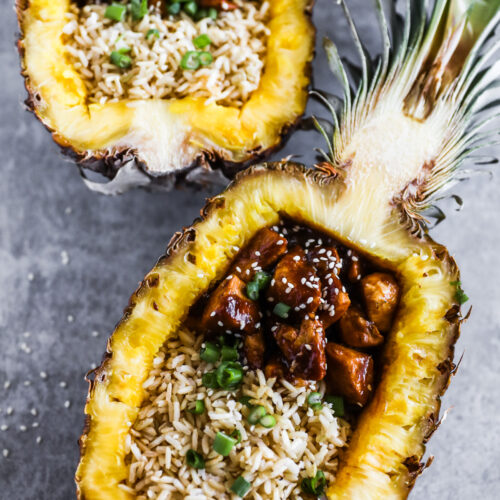
Pineapple Chicken With Rice Recipe
Chopped chicken is cooked with a pineapple teriyaki sauce, and served with rice in pineapple boats.
Tap Stars To Rate!
Serves: 2 pineapple boats
Ingredients
- 1 medium pineapple - with 1 cup of pineapple chunks reserved
Chicken:
- 1 ½ lbs boneless skinless chicken breasts - cut into bite sized pieces
- ½ tsp Salt
- ¼ tsp ground black pepper
- 1 Tbsp cooking oil - vegetable oil, coconut oil, olive oil etc.
Sauce:
- 1 cup pineapple chunks - from the pineapple boats
- ¼ cup soy sauce
- ¼ cup water
- 3 Tbsp brown sugar
- 1 tsp ginger powder
- 3 Tbsp rice vinegar - or apple cider vinegar
- 2 tsp cornstarch - or arrowroot powder
- 3 garlic cloves - minced
Serve With:
- 2 cups cooked rice - brown rice or white rice
- 1 green onion - chopped
- ½ tsp sesame seeds
Instructions
Prep The Rice:
- Cook 2 cups rice according to package instructions and the way you normally would. (I use a rice cooker).
Make Pineapple Boats:
- Make the pineapple boats by slicing 1 pineapple in half vertically. Cut an oval matching the outer shape of the pineapple that is 1-inch in from the outer edge and 1-2 inches deep. Now cut vertical and horizontal lines inside this oval shape also 1-2 inches deep. Scoop out the chunks, add to a bowl, and repeat cutting the vertical, horizontal, and oval lines until you’re left with a 1-inch thick bowl all the way around. Separate the core chunks (the tough center) to be used for the sauce.
Make The Sauce:
- To make the sauce, add the following to a blender. 1 cup of the pineapple chunks (include core chunks), ¼ cup soy sauce, ¼ cup water, 3 Tbsp brown sugar, 1 tsp ginger powder, 3 Tbsp rice vinegar and 2 tsp cornstarch. Blend until it creates a smooth creamy sauce.
- Chop 1 ½ lbs of raw chicken breasts into bite-size cubes.
- Heat a frying pan with 1 Tbsp cooking oil over medium-high heat. Once hot, add the raw chopped chicken. Season it with ½ tsp salt and ¼ tsp black pepper. Brown the chicken on all sides, but do not overcook. Transfer the cooked chicken to a bowl and set aside.
- Add the 3 minced garlic cloves to the frying pan over medium-high heat and cook for 1 minute. Pour in the blended sauce and heat for 1-2 minutes, stirring slowly until it begins to thicken.
- Add the cooked chicken back to the pan and mix everything. Let it warm for another 1 minute then remove from heat.
- Scoop 1 cup of cooked rice into the bottom section of each pineapple bowl. Spoon in the teriyaki chicken into the top half. Sprinkle the tops with 1 chopped green onion and ½ tsp sesame seeds. Serve and enjoy!
Tried this recipe?If you make this, please Leave A Review letting me know how it was!
Notes
This recipe will make 6 servings, but only 2 pineapple boats. The rest can be served in bowls with rice.
These pineapple boats won’t store well and should be served fresh. However, You can store the rice and cooked teriyaki chicken separately in the fridge.
- REFRIGERATE – Allow the chicken and rice to cool before placing it in an airtight container. You can keep this in your fridge for about 3-5 days.
- FREEZE – Add leftovers to an airtight container or freezer bag. Remove as much air as possible to prevent freezer burn. Store it in the freezer for up to 2-3 months.
Nutrition
Calories: 325kcal | Carbohydrates: 42g | Protein: 27g | Fat: 6g | Saturated Fat: 3g | Polyunsaturated Fat: 1g | Monounsaturated Fat: 1g | Trans Fat: 0.01g | Cholesterol: 73mg | Sodium: 330mg | Potassium: 628mg | Fiber: 2g | Sugar: 21g | Vitamin A: 142IU | Vitamin C: 74mg | Calcium: 43mg | Iron: 1mg
Nutrition info is auto-calculated and meant to be an approximation only.
Did You Try This Recipe?Please Do Me A Favor And Leave A Comment Below!